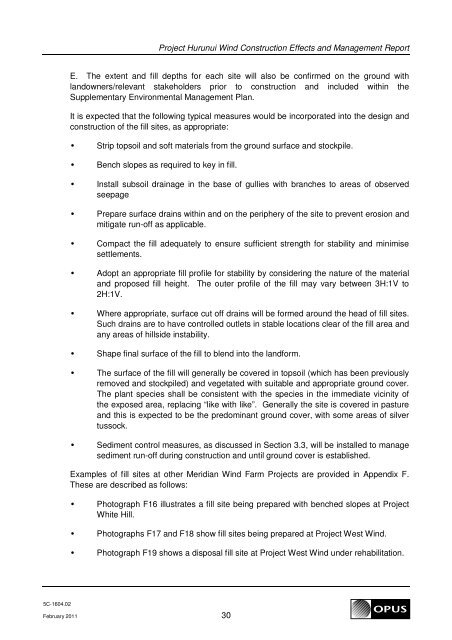Project Hurunui Wind Construction and Project Overview
Project Hurunui Wind Construction and Project Overview
Project Hurunui Wind Construction and Project Overview
Create successful ePaper yourself
Turn your PDF publications into a flip-book with our unique Google optimized e-Paper software.
<strong>Project</strong> <strong>Hurunui</strong> <strong>Wind</strong> <strong>Construction</strong> Effects <strong>and</strong> Management Report<br />
E. The extent <strong>and</strong> fill depths for each site will also be confirmed on the ground with<br />
l<strong>and</strong>owners/relevant stakeholders prior to construction <strong>and</strong> included within the<br />
Supplementary Environmental Management Plan.<br />
It is expected that the following typical measures would be incorporated into the design <strong>and</strong><br />
construction of the fill sites, as appropriate:<br />
• Strip topsoil <strong>and</strong> soft materials from the ground surface <strong>and</strong> stockpile.<br />
• Bench slopes as required to key in fill.<br />
• Install subsoil drainage in the base of gullies with branches to areas of observed<br />
seepage<br />
• Prepare surface drains within <strong>and</strong> on the periphery of the site to prevent erosion <strong>and</strong><br />
mitigate run-off as applicable.<br />
• Compact the fill adequately to ensure sufficient strength for stability <strong>and</strong> minimise<br />
settlements.<br />
• Adopt an appropriate fill profile for stability by considering the nature of the material<br />
<strong>and</strong> proposed fill height. The outer profile of the fill may vary between 3H:1V to<br />
2H:1V.<br />
• Where appropriate, surface cut off drains will be formed around the head of fill sites.<br />
Such drains are to have controlled outlets in stable locations clear of the fill area <strong>and</strong><br />
any areas of hillside instability.<br />
• Shape final surface of the fill to blend into the l<strong>and</strong>form.<br />
• The surface of the fill will generally be covered in topsoil (which has been previously<br />
removed <strong>and</strong> stockpiled) <strong>and</strong> vegetated with suitable <strong>and</strong> appropriate ground cover.<br />
The plant species shall be consistent with the species in the immediate vicinity of<br />
the exposed area, replacing “like with like”. Generally the site is covered in pasture<br />
<strong>and</strong> this is expected to be the predominant ground cover, with some areas of silver<br />
tussock.<br />
• Sediment control measures, as discussed in Section 3.3, will be installed to manage<br />
sediment run-off during construction <strong>and</strong> until ground cover is established.<br />
Examples of fill sites at other Meridian <strong>Wind</strong> Farm <strong>Project</strong>s are provided in Appendix F.<br />
These are described as follows:<br />
• Photograph F16 illustrates a fill site being prepared with benched slopes at <strong>Project</strong><br />
White Hill.<br />
• Photographs F17 <strong>and</strong> F18 show fill sites being prepared at <strong>Project</strong> West <strong>Wind</strong>.<br />
• Photograph F19 shows a disposal fill site at <strong>Project</strong> West <strong>Wind</strong> under rehabilitation.<br />
5C-1604.02<br />
February 2011 30
















